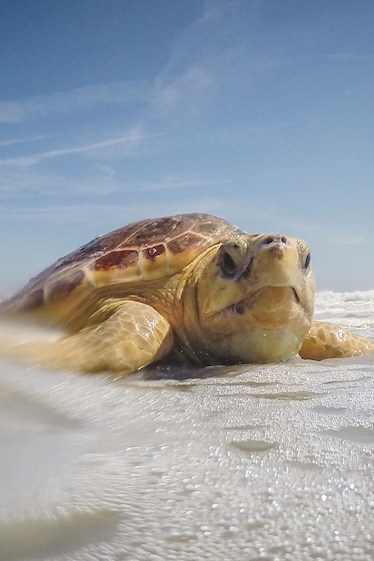From May to October in the southeastern U.S., five species of turtles, from loggerheads to Kemp’s ridley, crawl ashore under the cover of night to lay their eggs on the very beach they were born.
During this time, thousands of turtle-loving volunteers comb the shorelines looking for the reptiles’ tracks as part of an ongoing effort to gather population data and protect the nests from predators and human disruption.
Yet tracks in the sand can be misleading, as female turtles frequently make “false crawls,” clambering out of the water but returning without laying eggs. And since sea turtles disturb huge areas of sand to conceal their nests from predators, human monitors are often left guessing where the eggs are. (Read more about the dogs that put their noses to work saving wildlife.)
Now, a new study suggests man’s best friend can do it better. A scent-detecting dog named Dory pinpointed the location of sea turtle eggs more accurately than human volunteers, according to recent experiments published in the journal PLOS ONE.
“Conservation sniffers” like Dory could help scientists get a more complete picture of sea turtle nesting habits—crucial information when all U.S. sea turtle species are threatened or endangered, says study leader Rebekah Lindborg, a conservationist with Disney’s Animals, Science, and Environment division. (The Walt Disney Company is majority owner of National Geographic Media.)
A friendly competition
Lindborg teamed up with Pepe Peruyero, a dog behaviorist and former police K9 handler who has trained scent-detection dogs for more than 20 years. Peruyero selected a rescue dog named Dory, a two-year-old terrier mix found wandering along a Florida highway, as the project’s poster dog.
Over months of training on a 50-by-50 square foot artificial beach, Peruyero trained Dory to alert at the scent of “cloacal mucus,” a sticky substance that coats a sea turtle’s freshly laid eggs, with Lindborg as her handler.
Then, the team convinced the Florida Fish and Wildlife Conservation Commission to allow a friendly competition.
During the peak nesting seasons of 2017 and 2018, two dueling groups patrolled a stretch of shoreline about five miles long in Vero Beach, Florida.
Some days, Dory and Lindborg were responsible for flagging the location of sea turtle eggs based on Dory’s sense of smell. The rest of the time, it was up to a team of volunteers—some with a year’s experience, others with decades of dawn patrols under their belts.
What Dory found
The terrier had a keen nose for turtles, identifying 560 sea turtle nests from three species. People found only 256, though much of the difference is due to Dory working more days.
Dory was also significantly better than her human counterparts at choosing where to dig for eggs, substantially reducing the number of holes dug and overall length of a patrol, Lindborg reports. She was also harder to “stump”—while human volunteers couldn’t find the eggs in 14.8 percent of nests, Dory only failed to deliver 5.7 percent of the time. (Read how tracker dogs help save elephants in Africa.)
Dory got particularly good at pinpointing loggerhead nests, which accounted for about 80 percent of all nests found. But where human surveyors most need help are with species like the leatherback, an enormous reptile that can weigh up to 2,000 pounds. That’s because nesting leatherbacks disturb an area of sand the size of car, leaving monitors to dig hole after hole searching for the eggs.
“We can spend hours trying to find them and not be successful at all,” Lindborg explains. Due to the luck of the draw, the six leatherback nests found during the study fell on “Dory days,” so there wasn’t enough data for a direct comparison with human performance.
A supplement, not a replacement
Dory is the first dog to prove that canines can, at least in some circumstances, outperform humans in sea turtle-monitoring efforts.
Her achievement validates the handful of sea turtle-sniffing dogs who have gone before, such as a Cairn terrier, Ridley Ranger, who looked for eggs on a Texas barrier island, and Captain Ron, Peruyero’s own pet beagle who proved dogs could be trained to alert to cloacal mucus in 2016.
While Dory’s results are impressive, Matthew Godfrey, a sea turtle biologist for the North Carolina Wildlife Resources Commission, says veteran human volunteers can also home in on nests quickly and accurately. Godfrey says he wonders if Dory’s human competitors might have rivaled her performance if they, too, had been through months of intense training. (Learn more about how detection dogs learn to do their jobs.)
Regardless, a scent-detecting dog could make a difference in situations where time is of the essence, says Catherine Eastman, sea turtle program manager at the University of Florida’s Whitney Laboratory. That could be “when you’re under the gun” to relocate a nest that’s about to be flooded when the tide rolls in, or before heavy machinery rolls over the nest site for a construction project.
Dory is retired now, having traded dawn beach patrols for family life in Fort Lauderdale, Peruyero says. But Lindborg and her team hope she’s the first of many sea turtle sniffers.
“We’re really excited about the impact it could have for the sea turtle community—and conservation work in general,” Lindborg says.
